9781441152732.pdf by Unknown

Author:Unknown
Language: eng
Format: epub
Published: 0101-01-01T00:00:00+00:00
MURMUR
The lower hemisphere of the album cover makes sense
as an electron microscope photo, and not much elseâa
crawling, hyper-real jumble of polarized fibers. It could
be a photograph, or its negative. The intricate contrast
of dark and light is like a Surrealistâs rayograph of steel
wool, a conspiracy between everyday things in a dark-
room. When the lights are turned on, whatâs left is an
optical illusion of scale, a frozen surface like âa mass of
brown strings / like the wires of a gigantic switchboardâ
(from James Dickeyâs âKudzuâ), the opposite of the or-
dered circuitry on the cover of A Flock of Seagullsâ Listen.
The roiling quilt of kudzu begins to unravel about
two-thirds of the way up, giving way to a darkish blur
that only then starts to imply the depth of a natural space,
micro giving way to macro. Itâs a snapshot through a
time-lapse kaleidoscope where some facets click by in
milliseconds and others in millennia. Nearby is a dark
ruin of plant mass that looks like judgment from the
shadow of an imploding cathedral. Without reference to
the solid Georgia soil beneath, it could either be the
remnants of a whole farmhouse or just the overgrown
gravestones of its former tenants.
Beyond the ruins, the fibrillar dance of the foreground
slows, stratifying into weird sepia tendrils that stretch
beyond the top margin. Burnished out like the ghost
subjects of a Gerhard Richter painting, the tendrils dema-
terialize into the colorless sky beyond it, or maybe emerge
from it. The words R.E.M. and Murmur are superimposed in the top left corner in lettering thatâs the sublime blue-gray of a summer eveningâs dying light.
Itâs an utterly static image, with a gnawing subtext of
movement and drama. Are the fibers eating the forest,
⢠63 â¢
J. NIIMI
or merely providing cover for an unnamed darkness thatâs
about to engulf the entire tableau? Where is nature in
all of this, and what is the observerâs relationship to it?
We clearly see a haunted forest, except itâs still alive.
Maybe youâre the one haunting it.
In the South, kudzu haunts everything. Initially brought
to the US from Japan in May of 1876 for the Philadelphia
Centennial Exposition, Pueraria lobata (or kuzu to the Japanese) enchanted the fairgroundâs visitors with its fra-grant purple flowers and ivy-like deciduous leaves. The
vine had already occupied the imagination of the Japanese
for centuries; kudzu figures prominently in the epic eighth
century Manyoshu poems as a symbol of autumn. But
beyond its aesthetic beauty and Oriental exoticness, P.
lobata displayed another unusual quality that was particularly intriguing to its new American audience: the plantâs
astonishing growth rate, which wasnât so much an inert
quality as it was a full-on botanical sideshow. You can
experience the plantâs perfumed charms as the morning
sun evaporates the dew from its violet flowers, then split
to grab some lunch and a nap, and by the time you get
back a few hours later, the vines have become longer,
visibly longer. At the height of the summer season, a
kudzu vine can grow up to a foot and a half a day. One
could build a porch trellis in the spring, plant some kudzu
under it, and by the end of the summer enjoy the shade
of a fifty- to one-hundred-foot growth of vine around
the front of the house.
Download
This site does not store any files on its server. We only index and link to content provided by other sites. Please contact the content providers to delete copyright contents if any and email us, we'll remove relevant links or contents immediately.
Kathy Andrews Collection by Kathy Andrews(10506)
The remains of the day by Kazuo Ishiguro(7542)
Spare by Prince Harry The Duke of Sussex(4188)
Paper Towns by Green John(4163)
The Body: A Guide for Occupants by Bill Bryson(3789)
Be in a Treehouse by Pete Nelson(3206)
Harry Potter and the Goblet Of Fire by J.K. Rowling(3024)
Goodbye Paradise(2949)
Never by Ken Follett(2872)
Into Thin Air by Jon Krakauer(2695)
The Remains of the Day by Kazuo Ishiguro(2614)
The Genius of Japanese Carpentry by Azby Brown(2602)
The Cellar by Natasha Preston(2592)
Drawing Shortcuts: Developing Quick Drawing Skills Using Today's Technology by Leggitt Jim(2527)
120 Days of Sodom by Marquis de Sade(2428)
Architecture 101 by Nicole Bridge(2348)
The Man Who Died Twice by Richard Osman(2289)
Machine Learning at Scale with H2O by Gregory Keys | David Whiting(2264)
Fairy Tale by Stephen King(2058)
